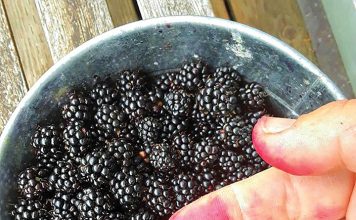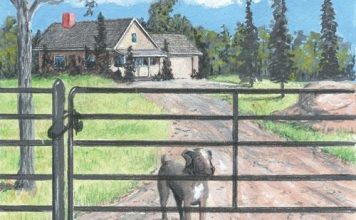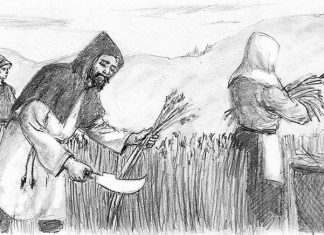By Jackie Clay-Atkinson
As a veterinary field technician for more than 20 years, I saw firsthand the frustration and heartbreak when animal owners called the veterinarian (or started treatment) too late to cure an animal. The key to saving an animal is learning to be observant for the very first signs of illness, then acting immediately. Let’s review symptoms of illness for common farm and working animals.
Dogs
Most dogs are eager eaters. When one who was previously enthusiastic about his feeding time suddenly doesn’t seem interested, that’s a red flag. Often, the first sign of a sick dog is a lack of appetite.
Since dogs are often house pets or are in direct contact with humans all day, it is easier to monitor their health. A dog who is beginning to feel ill will not be as active as usual. When a lively herding dog has to be encouraged to hop in the truck or help run a bunch of sheep through the barnyard, something is wrong. A healthy dog will pant when he’s excited, when it’s hot out, or when he’s been running hard. But he will quickly stop when he lies down in the shade, or when he rests for a few minutes, or when the excitement is over. A dog that pants while he is at rest is usually very uncomfortable or hurting somewhere.
Keep in the back of your mind how many times and how much your dog normally urinates. If your pet suddenly urinates very often or seems to pass very little urine … or if he urinates in the house when he usually is very well-mannered, something is wrong. Same thing if the urine is bloody, very dark, or has an unusual odor. These can be symptoms of a bladder infection, blockage, kidney infection, diabetes, or other diseases.
Any thick mucus discharge from the nose or eyes should be immediately addressed, as this can be a sign of serious illness such as canine distemper.
All dogs get a bit of diarrhea at one time or another. After all, they gobble down dubious “treats” like cow poop, candy wrappers, tin foil, and dead wildlife. But if your dog consistently has loose stools, take that as a warning that all is not well.
On the other side of the spectrum is constipation. When a dog strains and tries to go often, he may have a blockage. Feeding dogs cooked bones is one of the most common causes of a bowel blockage. Cooked bones do not digest in a dog’s stomach and often splinter and lodge in the intestinal tract. Even if you do not feed your dog cooked bones, he might have gotten into a neighbor’s trash.
Another common cause of constipation is impacted anal sacs. Dogs have scent glands on either side of their rectum that drain into the anus through a very narrow channel. Sometimes this channel gets plugged up and the glands collect abnormal amounts of creamy, foul-smelling material. The swollen sacs, coupled with the pain associated with passing a stool, make the dog reluctant to go and he becomes constipated. Dogs are sometimes seen dragging their behinds on the lawn or even carpet. This is not a sign of worms but a sign the dog is trying to squeeze his own anal sacs. Sometimes he is lucky and sometimes he needs help. You can learn to do this yourself; have your vet teach you.
Occasional vomiting is normal for dogs, especially after they have been eating grass. But when it persists, something’s wrong.
Any limping or dragging of a paw (unless you know the cause) could mean he has an injury. It could also possibly be a symptom of Lyme disease, a tick-borne disease.
All dogs scratch at themselves from time to time. But if it keeps up, something is wrong. It could be fleas or mange mites. But if he scratches at his ears, especially if his ears have a dark, smelly discharge, he probably has ear mites. This is a very common pest of dogs, especially those with thick, floppy ears. Dogs also can have dry skin, causing them to scratch.
Besides external parasites, dogs are prone to internal ones as well. If you notice anything that looks like bean sprouts in a dog’s (especially puppy’s) stool, you’re probably seeing round worms, the most common form of worms in dogs. If you see little bits of white that look like grains of rice clinging to the bare area around the dog’s rectum, look closer. They may move because they’re actually tapeworm segments.
If your dog’s breath is bad, look in his mouth. When you see red gums and brown stains on his teeth, he needs his teeth cleaned and may have infected gums from either a heavy tartar buildup or bad teeth.
The normal temperature of most dogs is 101.5° F to 103° F. Large dogs often have a lower body temperature whereas small dogs have a higher temperature. But to be sure, take your dog’s temperature with a rectal thermometer when he is well and jot it down where you can find it easily. Then if you suspect he’s feeling ill, take his temperature and compare.
Some dog illnesses can be taken care of at home. For instance, if he has a limp and you discover a thorn, you can pull it out and soak his pad with Betadine. But if you don’t know what’s wrong or you know he’s running an above-normal temperature, take him to your vet right away. He stands a much better chance of complete recovery if you do.

Cats
Because cats are frequently outdoors, we may not see them as often as we do our dogs. (Unless it’s our cat, Mittens, who sleeps with us every night and has got us trained as to when she wants to be fed!)
Often the first symptom of trouble with cats is a lack of appetite. Even cats who are given access to free-choice dry food should actually be eating their food. If the dish remains full, check the food first, replacing it with fresh. If the cat still isn’t interested, you may have a problem.
Almost everything pertaining to dogs also pertains to cats. But cats do have a few different and/or extra concerns. If you see a cat, especially a neutered male, going to his litter box or pawing holes in the dirt outside frequently, then staying in position for an unusually long time, check the results. There should be a decent-sized wet spot. If only a couple drops are in there or if the cat box is dry, pay attention. This is often a sign of a urinary blockage that neutered male cats are prone to called cystitis. Crystals in the urine settle and form sand-like particles which can lodge in the urinary tract. Left untreated, this can quickly kill a cat.
Sneezing and runny eyes or nose are also of concern. One or two sneezes can be normal, but if it continues or the cat rubs its eyes or nose with its front paws often, suspect a problem.
Any damp, matted hair bears a closer look as cats are prone to abscesses from cat fights. Some will heal without treatment, but others can become infected and cause trouble down the line.
Should your cat, especially an older cat, start limping, pick it up and check each of its claws. Some cat’s claws will grow so long they’ll actually pierce the pads of their feet, causing pain. They can easily be clipped off and removed from the pads. Keep an eye on this in the future, as it will usually recur.
Because cats often catch and eat rodents (hosts to tapeworm), they can become infected themselves. So if you notice little white objects stuck to your cat’s behind, they are probably tapeworm segments.
As with dogs, know your cat’s normal body temperature. It should be about 101.5° F. Record it in a safe place. Then if your cat acts a bit “off,” take its temperature. If it has an elevated temperature, call your vet.
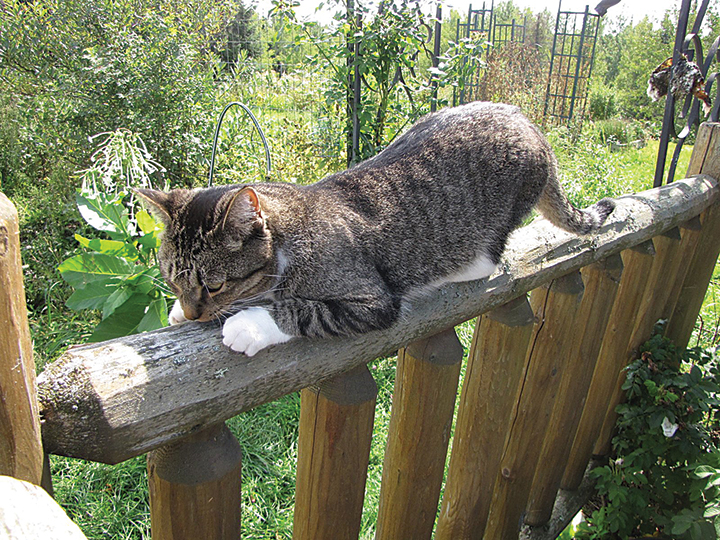
Rabbits
Although rabbits are usually very healthy, due to their being caged in isolated buildings, it’s always a good idea to keep an eye out for anything out of the norm.
For instance, if one of your rabbits usually sits and looks at you when you walk by every morning, then one day it is in the back of the cage with its back humped up, suspect a problem.
If the feeder is not as empty of pellets as it usually is at feeding time, look closely at your rabbit. If he is ill, he will not want to eat.
Sneezing or a discharge from the eyes or nose is not normal. Rabbits with wet spots on the inside of their front legs have been wiping their nose or eyes. Keep a close eye on any rabbits with these symptoms. It could be a disease called “snuffles,” which requires prompt treatment and isolation, as it is very contagious.
A rabbit with damp-appearing hocks or feet, especially one who limps, should be taken out of the cage and examined closely. He may have sore hocks and require treatment and special care.
All rabbits should appear shiny, active, and roundish in shape. Any with rough coats (with hair that sticks up in places) should be checked over carefully.
Watch for diarrhea. A healthy rabbit has firm, round, pelleted manure. At the first sign of diarrhea, isolate and get treatment for your rabbit.
Poultry
Most poultry exhibit the same symptoms when ill, so for the lack of more space in this article, we’ll combine them all. Likewise, I’m going to refer to all poultry as “chickens” so don’t let that throw you.
The first thing you’re likely to notice with a sick chicken is that it sits in a corner or nest box with its feathers all fluffed out. Perhaps its eyes are partially closed.
A chicken with nostrils matted with mucus or a sound in its breathing like it has a cold has a respiratory illness, possibly pneumonia.
Diarrhea in chickens can be a symptom of illness. I know, chickens usually poop kind of messy. But if it is very runny or mats to their backside, pay attention. In baby chicks this can be a sign of coccidiosis, which can kill them pretty fast.
When a laying hen sits in the nest box straining to lay an egg with no results, pick her up and carefully examine her for a hard bulge just behind her vent. She may be egg-bound and may need help to pass the egg. But all hens who refuse to leave the nest box are not eggbound — some are just going “broody,” which means they want to sit on a clutch of eggs and hatch them.
A healthy chicken has smooth legs. Some chickens, especially older ones, will develop rough scales on their legs and toes. This is scaly leg, caused by mites. On the same subject, if you notice a chicken picking and scratching at herself excessively, examine her well. She may have mites or lice.
Unfortunately, as chickens are quite small, they often just up and die before you have a chance to notice something’s wrong. Should this happen with an occasional bird, don’t panic, especially when they’re several years old. But when more than one dies in a relatively short time, try to discover what is wrong before you lose more.
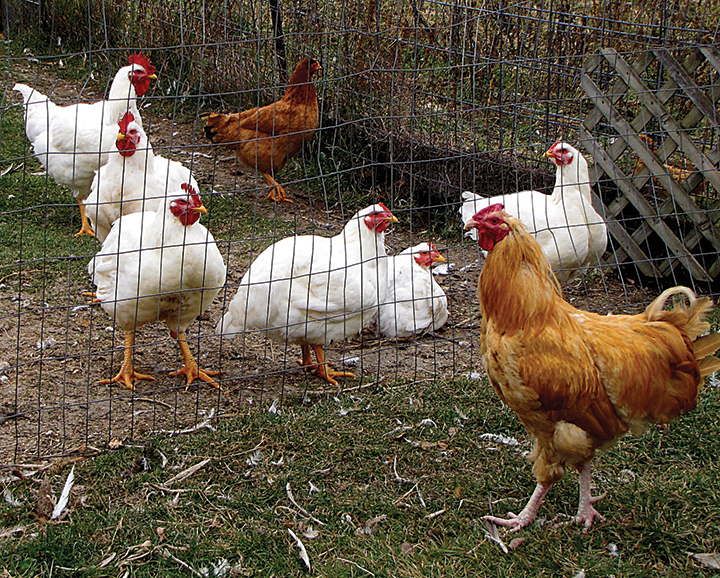
Goats and sheep
When it comes to signs of illness, goats and sheep are pretty much the same so for the sake of brevity in this article, I grouped them together.
Usually the first sign you’ll have when a goat or sheep is not feeling well is that a previously active and alert critter will stay in the barn when the others come out to eat or visit with you. Pair this with a reduced lack of appetite, and you can be pretty sure something is wrong. A healthy goat or sheep will always be hungry, especially for grain.
An occasional cough is normal with these animals. But a persistent cough, especially when combined with a lack of appetite, could be the start of a respiratory disease or pneumonia.
Any sign of diarrhea should be taken seriously. The animal should be examined carefully. Eating toxic plants can cause diarrhea in sheep and goats, as can coccidiosis, internal parasites, and such diseases as shipping fever complex.
A hard, swollen udder should always be checked right away. Squeeze a bit of milk onto a clean cloth. Any “cottage cheese-like” clots, blood, or other changes in the milk (being thicker than normal or watery-looking) can indicate mastitis. Before a mother gives birth, the milk is normally thick and yellowish because this is the colostrum, so if that’s the case, don’t worry. If the udder seems hot or painful, check the animal’s temperature as she may have mastitis, even before the mother gives birth.
Limping in sheep and goats can be caused by a fungal infection called foot rot, but it is most often caused by overgrown hooves. If your animal starts limping, restrain it and examine the feet well; usually a trimming is called for.
Should your sheep or goat suddenly act ill and have a very big belly, suspect bloat and call a veterinarian at once. (Bloat often happens after an animal escapes and eats too much grain or is turned out onto lush pasture.)
Wethers (castrated males) are sometimes kept for pets or pack animals. If your wether tries to urinate with little or no results, suspect a blockage or urinary tract infection. Wethers, especially goats, are prone to these problems.
As with other animals, take the temperature of your sheep and goats (if you have a limited number), and record this information while they’re healthy. The normal temperature of a sheep or goat is between 102.5° F and 103.8° F. A fever coupled with other symptoms of illness warrants immediate treatment.
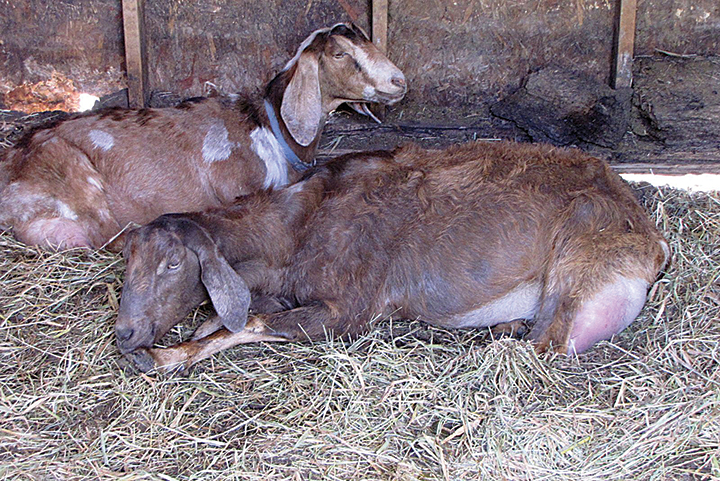
Cattle
Both beef and dairy cattle exhibit the same signs of health and illness. Again, for the sake of saving space, I’m going to refer to these critters as “cows” although they may be steers or bulls.
A healthy cow will have a shiny, slick coat and bright eyes. She will come right up to eat and will be seen feeding often in pasture. Her nose will be moist but never crusty or thick with mucus. As with most animals, the first sign you’ll have of a sick cow is lack of activity and appetite.
Always listen for coughing around your cows. All of them will occasionally cough. But if it is frequent or has a rattle, pay attention.
A little mucus on the nose, usually licked away by their tongue, is normal (although kind of gross). But if the mucus is whitish and keeps appearing, your cow may have pneumonia or shipping fever.
Diarrhea, called “scours” in calves, can quickly become serious, especially in young, bottle-fed calves and older cattle. It is very normal for cows turned out onto fresh, lush pasture to have quite loose stools. But if your cow has not been turned onto a new pasture or is a bottle-fed or even nursing calf, treatment should be given rapidly.
If you spot your cow suddenly standing around or lying down with a big, hard belly, suspect bloat and get treatment at once. Cows cannot throw up or belch great quantities of gas. So when the belly becomes blown up with copious amounts of gas from eating too much grain or lush pasture, it swells and can kill her.
Cows will try to eat larger foods without always pausing to chew them well. So if you notice your cow standing with her neck stretched out, frothing at the mouth, think about what she has eaten. Is she under an apple tree where fallen ripe apples are common? Did you just feed her some corn on the cobs? These are two most common causes of food choke in cows. She can choke and strangle on this obstruction, so get help. Be aware that frothing can be a symptom of rabies. So if you live in an area where rabies has been found, don’t just reach your bare hand into her mouth.
A cow that often stands humped up and appears to be losing weight (while still eating fairly well) should be examined by a veterinarian. It is possible that she has a condition called “hardware disease.” For some strange reason, cows love to eat metal items, ranging from nails to steel broom bristles and old rusty tin cans. This metal does not pass through the cow but stays lodged inside. Eventually, it can kill her. If caught early enough, a magnet in the form of a large bolus can be given, which collects any steel hardware, not letting it migrate to her heart or prick her stomach as she digests food. In New Mexico, the previous owners of our ranch had burned several small outbuildings. We used magnets and removed every old nail we could find. But our milk cow found more and ate them. Yep, she came down with hardware disease and had to have a magnet put down her. Thankfully, she cleared up within a week’s time.
As with other animals, take and record your cow’s normal temperature, then be sure you can find this information when you need it. The average normal temperature of cattle is 101.5° F.
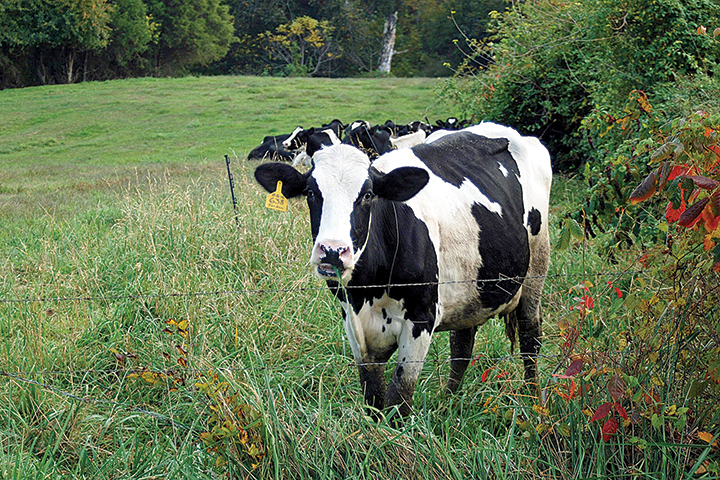
Pigs
Pigs have a healthy appetite. If your pig starts rejecting his feed, suspect something’s not right. Likewise, if he just lies in a corner of his pen, not getting up and moving around as normal, keep a close watch.
Pigs cannot sweat and panting does little, as their tongues are not large enough to help cool their bodies. Pigs are very prone to heat prostration, which can kill them, so in hot weather they need a wallow or old bathtub with water in it so they can cool off.
All pigs scratch and rub on things. But if they start scratching and rubbing a lot, or if you notice red areas on their bodies or thickened skin, suspect mange mites at work.
As pigs usually root in the ground and aren’t too picky about what they eat, they can ingest worm eggs. If you notice your pigs aren’t as nicely round as they should be, consider worms.
Pigs normally snuffle and snort, but if one starts to have a discharge from his nostrils or begins sneezing or coughing, it could be a sign of a serious problem — anything from pneumonia to rhinitis.
Pigs are hard to handle unless you have a good chute, so know that the average temperature of a pig is 102.5° F. When a pig seems ill, take its temperature. An elevated temperature definitely means something’s wrong.
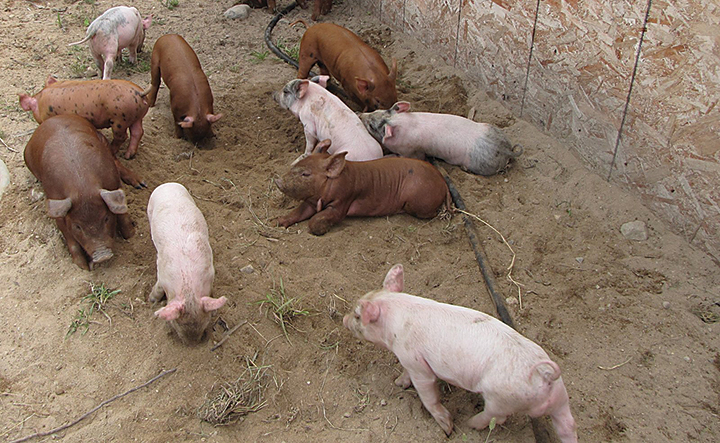
Horses
Although horses are large animals, they are really quite sensitive. When a horse demonstrates signs of illness, take it seriously. Horses are active animals. Be suspicious if you see your horse standing around, not eating or grazing. And, as they are herd critters, take note if one stays away from the others or stands in the barn with its head down while the other horses are out grazing.
Horses roll on the ground for pleasure and to scratch their backs. But if you see a horse rolling for more than a few minutes, especially if they kind of crouch down, then get up, move a few feet, then do it again, get help immediately as this is a red flag for colic. Horses don’t burp, so trapped gas can cause a severe belly ache. This makes the animal roll, trying to relieve the pain. Without help, colic can kill them.
Watch out if a horse begins limping and standing with its forefeet out ahead of its body. Any lameness is a sure sign of trouble, but founder, often caused by eating too much lush pasture or too much grain, needs to be addressed immediately or the horse may become permanently lame.
Should you notice your horse getting thin despite his good diet, having a mucus discharge from his nostrils, or spitting out “wads” of partly chewed hay or grass, suspect a bad tooth or sharp edges on his teeth which need to be filed (floated) by a veterinarian. A horse with sharp teeth will also sling mouthfuls of grain around or dribble it as he eats.
Horses will occasionally cough. A bit of dust, insects, or hay chaff can cause coughing in a healthy horse. But if you notice your horse coughing a lot or seeming to cough unusually hard and deep, suspect something’s wrong. Horses are prone to a condition known as heaves, often caused by feeding moldy hay. This can result in the animal being unable to handle the stress of riding or driving, if left untreated. Coughing can also mean pneumonia or another upper respiratory illness, especially when coupled with discharge from the nose.
As with other animals, be sure you know your horse’s normal body temperature as it can vary from animal to animal. But the average normal temperature is between 99° F to 101° F.
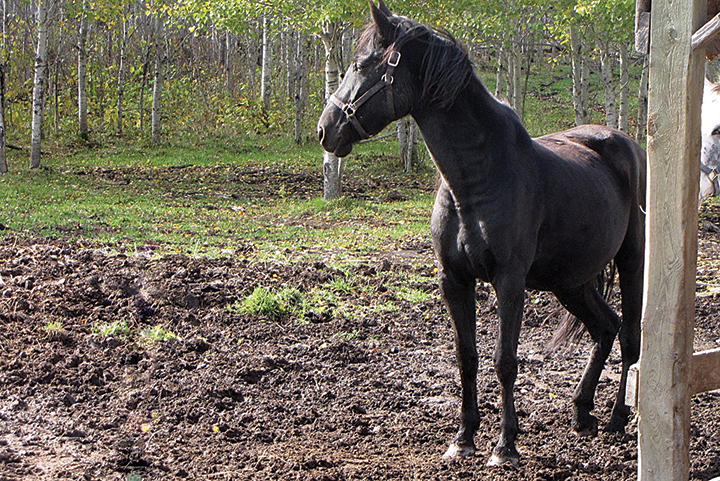
Treating your sick animal
If your animal shows any of the warning signs mentioned above, the very best option is to call your veterinarian at once. Some people wait a day or so to see if things get better, but usually the animal suffers from this delay and it can cost its life.
Sometimes a veterinarian is simply not an option, so you have to use your own skills. Do yourself a favor and pick up a book for laymen on veterinary care. Most common illnesses in animals and poultry are treatable with antibiotics. Usually larger animals are given injectable antibiotics such as penicillin or tetracycline. These can be purchased through your veterinarian and your local farm/feed store or online from farm companies. Besides the antibiotic, you’ll need to know how to give an injection and where it is best given.
Smaller animals and poultry are most often given oral medication. With chickens, there is powdered tetracycline which is available through most farm stores. Calves, goats, and sheep are given both injectable antibiotics and oral boluses (pills), either antibiotics or sulfa drugs, often bought under the brand name of Sustain III®.
For household pets, many veterinary supply houses require a prescription from a veterinarian in order to buy antibiotics. Many folks get around this by buying human antibiotics relabeled as fish or bird antibiotics, which are available without a prescription through pet stores and online supply houses. If you choose that route, have some on hand at all times unless you have quick access to a pet shop which carries them. You will have to calculate the correct dose as many are in capsules meant for humans, originally.
If you do choose to medicate your animal yourself in an emergency, continue the antibiotic for at least five days, regardless of whether your critter starts to act better immediately. If you don’t, the causative bacteria may well become resistant to the antibiotic and the illness will return with a vengeance.
Bear in mind that not all sick animals respond to antibiotics. Such things as bloat, colic in horses, lameness, and viruses all require different treatment. So, again, if it is possible, call your own vet at once.









